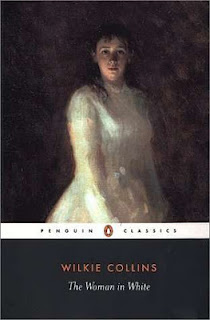The Woman in White
Summary (from the publisher): The Woman in White is a Victorian melodrama concerning a mysterious woman in white who bears an uncanny resemblance to the fiancee of Lord Glyde, a sophisticated fortune hunter. First published as a serial between 1859 and 1860, this chronicle of evil, suspense, and villainy is believed to be the first English novel to deal with crime detection.
Review: I've been dying to read The Woman in White since I read Nora Ephron's high praise for it in I Feel Bad About My Neck: "I open Wilkie Collins's masterpiece, The Woman in White, probably the first great work of mystery fiction ever written (although that description hardly does it justice), and I am instantly lost to the world. Days pass as I savor every word. Each minute I spend away from the book pretending to be interested in everyday life is a misery. How could I have waited so long to read this book? When can I get back to it? Halfway through I return to New York to work, to mix a movie, and I sit in the mix studio unable to focus on anything but whether my favorite character in the book will survive. I will not be able to bear it if anything bad happens to my beloved Marian Halcombe. Every so often I look up from the book and see a roomful of people waiting for me to make a decision about whether the music is too soft or the thunder is too loud, and I can't believe they don't understand that what I'm doing is much more important—I'm reading the most wonderful book."
The Woman in White is told largely from the point of view of Walter Hartwright, a young drawing master who is hired to teach two half sisters to sketch. Walter falls in love with Laura, one of the sisters, but leaves when he learns Laura is engaged to Sir Percival Glyde. In short, Laura is duped into marrying Glyde, who is merely after her money and her identity is ultimately confused with the mysterious "woman in white," Anne Catherick. Walter and Laura's sister, Marian, set out to right the grave injustice committed against Laura through careful and well thought out detection. Glyde's co-conspirator, Count Fosco, becomes the true villain of this novel, as Walter reveals the heavy hand Fosco played in wrecking Laura's life and inheritance.
I really liked many of the characters of this novel, especially Walter and Marian. Laura's invalid uncle Frederick Fairlie provided comedic relief. Additionally, I especially liked that the true villain, Count Fosco, was not pure evil but had some redeeming features, including his admiration for Marian, which made him a more well rounded character. One of my favorite aspects of this novel was the many points of view featured in the narrative. I enjoyed the frame story of Walter setting down the tale and entreating others to write down their role. It sort of reminded me of how modern trials play out with each witness telling their versions of events.
However, I sadly did not enjoy this novel as much as Nora Ephron, although I suppose it had a lot to live up to with her high praise. I was also annoyed with Laura Fairlie throughout. She's an exceedingly weak and frail character and I vastly preferred the strong heroine Marian Halcombe. I was disappointed that Walter would chose the weak but pretty Laura to the strong and intelligent partner of Marian. This novel was also quite long winded and took me forever to get through. However, I know that was the style of the day, as reading was one of the main forms of entertainment (and this was released as a serial).
All in all an enjoyable read, that ushered in the modern crime detection that millions today read and love.
Stars: 3



Comments
Post a Comment